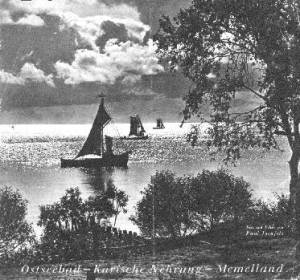What's this about - a necessary preface

What's this about? - A preface
Nidden is a little village on the Courland Spit (Kurische Nehrung). Located
in the district of Memel in East Prussia, Nidden counted about 800 inhabitants.
Most of them fled in 1945 from the approaching Russian army. Today Nidden
(in Lithuanian: Nida) and the Memel territory belong to Lithuania. The other
half of the Courland Spit is situated in the area of the Russian region Kalinigrad
(Königsberg). More or less the whole population has been replaced after
the war; the new inhabitants came from Lithuania and Russia.
Today there are some attempts to reconstruct the history prior 1945: a little museum has been built in Nidden and contacts with former inhabitants and German scientists were made; the erstwhile summer residence of Thomas Mann is used as a place for cultural meetings and exhibitions. Lithuanian museums, as well, are making an effort to display East Prussian artists, who had painted the Courland Spit among other subjects. For example, there's a virtual exhibit of Erich Mollenhauer at the website of the Museums of Lithuania.
The family of my father comes from Nidden and I'm trying here to show a little of how life in Nidden has been back then. If you want to understand the present and our own roots, it's necessary, I guess, to take a look at the past. After World war II the East Prussian territory has been divided and given to Poland and Russia and yet my generation, I've been born 1963, has to dig deeply into history books to find out something about this former part of Germany with its 600 years of German history. A place that's nearly forgotten today, it seems.
Of course, the former inhabitants could remember a lot about their home, though there are some aspects of the time period from 1939 to 1945, when the Memel area has been coming back in the Third Reich ("heim ins Reich"), they don't like to speak about at all. Additional, the period from 1923 to 1939 is not easy, politically, especially for the Lithuanians, because after the First World War the Lithuanian military occupied the Memel territory contrary to the orders of the Allied Council (and a plebiscite) and "kept" it for the next sixteen years as a Part of Lithuania. This had been for most of the German inhabitants a Lithuanian "occupation", for many Lithuanians a legal action, which had been accepted at least afterwards by the Control Council with some requirements as a bilingual administration.
Both Germans and Lithuanians are a little bit distant when it concerns the political history of the Memel territory, talking about it feels sometimes like stepping into a still dangerous area. The two parties tend to describe the history in a rather folkloristic way - professional historians excluded - sparing any political perspective. Nonetheless they are moving closer to each other and every further development will be definitely exciting.